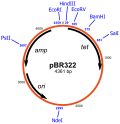Restriction sites, or restriction recognition sites, are located on a DNA molecule containing specific (4-8 base pairs in length) sequences of nucleotides...
5 KB (629 words) - 16:22, 23 July 2024
recognition sites within molecules known as restriction sites. Restriction enzymes are one class of the broader endonuclease group of enzymes. Restriction enzymes...
55 KB (5,853 words) - 14:21, 27 September 2024
polymorphism itself, as detected through the differing locations of restriction enzyme sites, or to a related laboratory technique by which such differences...
9 KB (1,159 words) - 04:36, 23 May 2023
Restriction site associated DNA (RAD) markers are a type of genetic marker which are useful for association mapping, QTL-mapping, population genetics,...
13 KB (1,424 words) - 22:05, 2 December 2023
well. In a restriction digest, DNA molecules are cleaved at specific restriction sites of 4-12 nucleotides in length by use of restriction enzymes which...
6 KB (784 words) - 02:16, 13 March 2024
does not have a Type IIS restriction enzyme recognition site, the correctly-ligated product cannot be cut again by the restriction enzyme, meaning the reaction...
18 KB (2,489 words) - 05:22, 30 April 2024
the availability of suitable restriction sites flanking the site that is to be mutated. The limitation of restriction sites in cassette mutagenesis may...
25 KB (2,980 words) - 07:09, 8 September 2024
multiple cloning site (MCS), also called a polylinker, is a short segment of DNA which contains many (up to ~20) restriction sites - a standard feature...
5 KB (683 words) - 08:04, 18 May 2024
Physical mapping (section Restriction site mapping)
of physical mapping are fluorescent in situ hybridization (FISH), restriction site mapping and sequencing by clones. The goal of physical mapping, as...
13 KB (1,642 words) - 10:58, 23 July 2024
A restriction map is a map of known restriction sites within a sequence of DNA. Restriction mapping requires the use of restriction enzymes. In molecular...
4 KB (613 words) - 06:50, 30 December 2023
sequence recognized for cleavage by a restriction enzyme is called the restriction site. Typically, a restriction site will be a palindromic sequence about...
25 KB (2,688 words) - 14:55, 15 October 2024
either blunt or overhung ends, either at or nearby the recognition site. Restriction enzymes are quite variable in the short DNA sequences they recognize...
8 KB (1,087 words) - 08:23, 12 September 2023
This article contains a list of restriction enzymes whose names start with A and have a clearly defined cutting site. The following information is given...
80 KB (3,046 words) - 23:44, 27 August 2024
complementary to the adaptor sequence, the restriction site sequence and a few nucleotides inside the restriction site fragments (as described in detail below)...
7 KB (708 words) - 07:57, 22 February 2024
for profiling of microbial communities based on the position of a restriction site closest to a labelled end of an amplified gene. The method is based...
15 KB (1,966 words) - 06:45, 29 November 2023
Nuclease (redirect from Site specific nuclease)
isolated examples of the two types of enzymes responsible for phage growth restriction in Escherichia coli (E. coli) bacteria. One of these enzymes added a...
22 KB (2,538 words) - 13:28, 11 September 2024
microalgae. Site-specific recombination makes use of phage integrases instead of restriction enzymes, eliminating the need for having restriction sites in the...
61 KB (7,073 words) - 16:39, 29 April 2024
HindIII (category Restriction enzymes)
HindIII (pronounced "Hin D Three") is a type II site-specific deoxyribonuclease restriction enzyme isolated from Haemophilus influenzae that cleaves the...
9 KB (1,045 words) - 08:36, 9 August 2024
process called restriction. Each restriction enzyme is highly specific, recognising a particular short DNA sequence, or restriction site, and cutting both...
3 KB (363 words) - 02:41, 11 March 2023
cloning schemes, as it requires fewer steps and fewer reagents. No restriction site scar remains between two DNA fragments, but the region between the...
6 KB (689 words) - 15:42, 24 May 2024
amplification is directed across the altered restriction site, and the products digested with the restriction enzyme. When fractionated by agarose or polyacrylamide...
1 KB (158 words) - 02:30, 24 March 2021
Erlich, "Enzymatic Amplification of β-globin Genomic Sequences and Restriction Site Analysis for Diagnosis of Sickle Cell Anemia"—the polymerase chain...
89 KB (11,135 words) - 11:52, 26 August 2024
used in plant breeding. Although GBS presents an approach similar to restriction-site-associated DNA sequencing (RAD-seq) method, they differ in some substantial...
7 KB (842 words) - 21:01, 3 December 2023
random occurrence of a Restriction site, a 4-bp sequence can occur once every 256 bp. A restriction enzyme having a recognition site of more than 4 bp would...
4 KB (608 words) - 16:23, 17 December 2021
Isoschizomer (category Restriction enzymes)
unmethylated forms of restriction sites. In contrast, the other restriction enzyme can recognize only the unmethylated form of the restriction site. This property...
2 KB (245 words) - 04:50, 16 September 2023
the methylation dependent retention or loss of CpG-containing restriction enzyme sites, such as those for TaqI (TCGA) and BstUI (CGCG), depending on whether...
12 KB (1,300 words) - 12:11, 5 June 2023
human anus Relative abundance distribution, a measure of biodiversity Restriction site associated DNA markers, a type of genetic marker Right axis deviation...
4 KB (487 words) - 23:50, 22 June 2024
and is then cleaved using a restriction endonuclease called an anchoring enzyme (AE). The location of the cleavage site and thus the length of the remaining...
17 KB (2,127 words) - 11:27, 13 August 2023
vector is treated with a restriction endonuclease to cleave the DNA at the site where foreign DNA will be inserted. The restriction enzyme is chosen to generate...
32 KB (4,016 words) - 17:56, 20 August 2024
restriction sites for more than forty restriction enzymes. Eleven of these forty sites lie within the TetR gene. There are two sites for restriction enzymes...
13 KB (943 words) - 06:28, 25 July 2024












